This is a re-post from a previous year.
Spring Gardening in the Pacific NW
As I walked through my favorite local nursery last weekend, it took every last ounce of willpower to hold back. That place turns me into a crazy person. All the plants! All the possibility! I settled on some kale and lettuce starts and three packets of seeds: beets, carrots, peas.
The broccoli and sweet onions were calling my name. Strawberries! Kohlrabi! Cauliflower! So many plants, so little time. I was proud of my restraint. My goal was to buy only what I had time to plant in one afternoon.
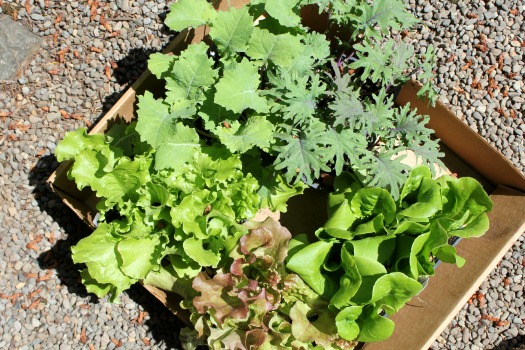
The benefit of walking through a local growing center is that it will give you a good idea of what you could be putting in the ground now. You don’t necessarily get the same benefit if you head to a large chain, like Home Depot. Just because you can technically buy a tomato plant right now doesn’t mean you should.
Certain plants do great being directly sown into the soil once the danger of frost is past. Others do better in May-June when the weather turns warmer. Check out the regional planting information on the back of the seed packets or plant starts (and our planting tips for vegetable seeds & starts). Again, the folks at your local nursery will be way more helpful in this department.

This spring, the first order of business for us was to remove this huge tree from the corner of our property. This sat just above our sloped garden area, near the spot where we plan to put the chicken coop. It had 5 big trunks that were starting to rot at the base. No bueno. My husband loves working with a chainsaw so he was like a kid in a candy store, with a huge grin on his face the whole day. He did a beautiful job dropping the tree and cleaning up the branches. Thankfully, it came down before the branches were fully leafed out. It’s still a big pile of tree debris that will take awhile to clean up completely.
We have declared 2015 to be the Year of the Chicken (similar to 2013 and 2014) at our house! We purchased the building materials over a year ago; we’re hoping to start on that project this month.
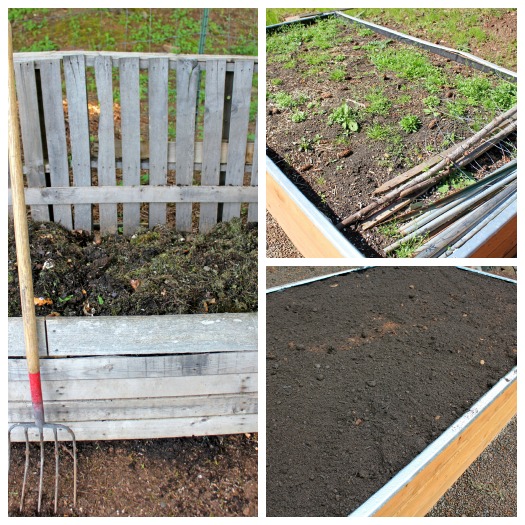
While my husband was working on the tree, I pulled on a pair of gardening gloves and got to work on my sadly neglected raised garden beds. I pulled all the weeds and added two wheelbarrows full of compost to each raised bed. (For more details on that, read Composting Made Simple.) Now it was my turn to wear a permagrin. I love playing in the dirt.
Anytime I’m working with the soil in my garden, it reminds me of a gardening class I attended a few years ago. The woman teaching the class was a local CSA farmer (new to CSA’s? Find out how they work here.). She was talking about how she had worked hard to improve the soil quality in her garden. It took years, but she slowly transformed it from hard, rocky clay to beautifully balanced, fertile soil. She said she was proud of her soil. At the time, that struck me as funny. Now I totally get it. That compost? I helped make that! This rocky ground? It now produces a crazy amount of food! Soil pride. It’s a thing.
In our temperate Northwest climate, we really do have an extended growing season. Every year, I am trying to start earlier and stretch things out longer. Green houses, hoop houses. It really is possible to garden year-round. Ack! I don’t know! I find I actually like to hibernate in the winter. After a long season of growing and preserving, I am ready to put my feet up in November. But I love the idea of starting plants in March and working through October. For now, that schedule works for me. It feels good starting in early spring and finishing in late fall.
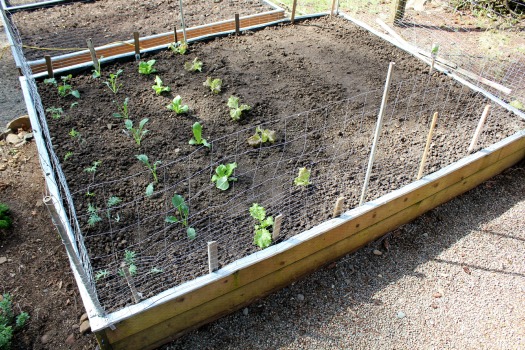
In this raised bed, I planted green, leafy vegetables: kale, lettuce, spinach. This is the one raised bed that needs a rabbit fence around it. It also works beautifully at keeping out toddlers.
I put in kale and lettuce using starts (young plants). Six plants cost just over $2. One bunch of kale in the grocery store is usually $2-3! By juicing regularly and eating a vegetable-based diet, we go through quite a few greens. I love picking them from my garden instead of picking them up at the grocery store.
I planted the spinach (and some sugar snap peas around the fencing) using seeds. I do a mix of planting seeds and starts. Thanks to our early warm spring, cold-weather seeds could have been directly sown in the ground as early as February. Someday, when I have a greenhouse and a better system for seeds, I think I will enjoy this route more. For now, I kind of love the instant gratification of working with starts.
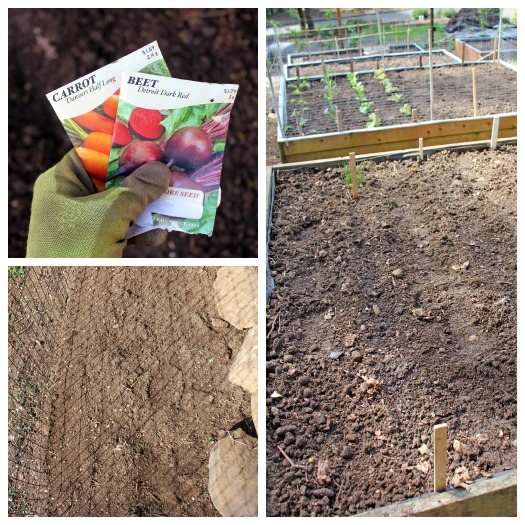
This bed normally holds my garlic (find out how to grow garlic here). I skipped the garlic this year (which I will regret in July) and directly sowed beet and carrot seeds here. Then we had pounding rain and hail for a week straight. I’m worried my seeds are going to rot in the ground. Did I mention I love starts? My original plan was to do succession planting, every three weeks or so. We’ll see how these little guys do.
What about you? Have you put anything in the ground yet?
**********************************************
If you are looking for more information on gardening in the Northwest, check out The Timber Press Guide to Vegetable Gardening in the Pacific Northwest (Amazon). I own this book, and it is a great resource. Gardening tasks and tips are divided by month, so it’s easy to find information and track with the growing seasons. This would be a great book for a beginning gardener or resource for a seasoned one. If you live in a different part of the US, check out the other regional Timber Press Guides.
Find more gardening posts here.
This post may contain affiliate links. See the disclosure policy for more information.
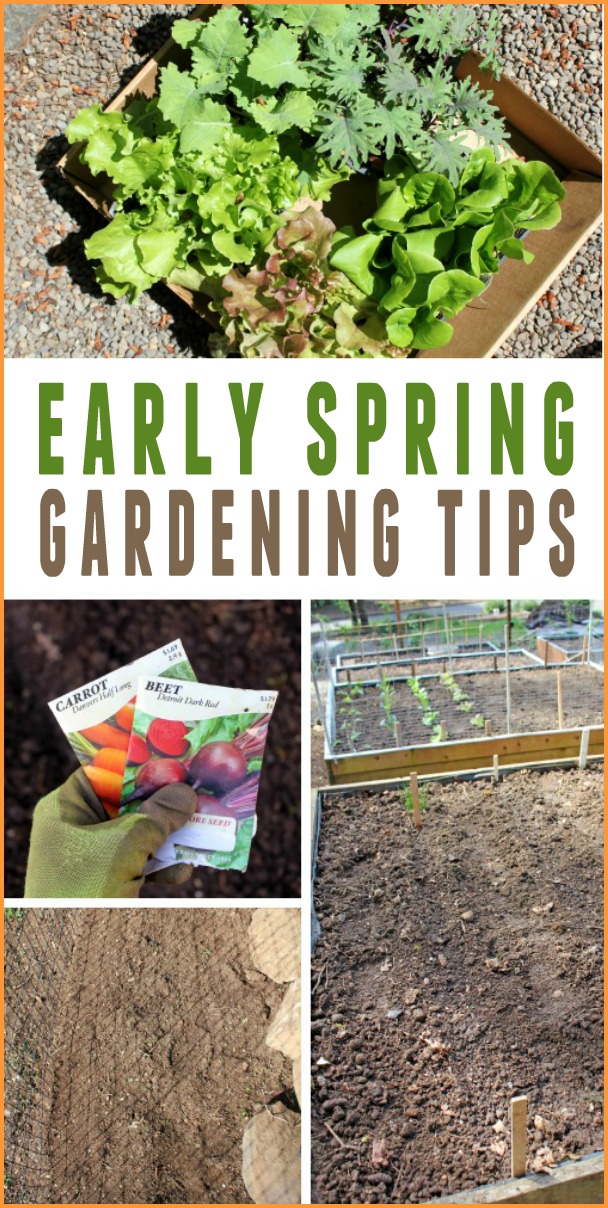

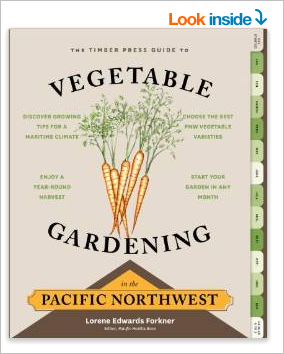
Do you mind sharing which local nursery is your favorite? I like the idea of buying starts at a nursery so that you know the plants are acclimated to the climate here, but I am unsure where to go. Thanks! We are on the SE side of things.
It might be a drive for you, but I love Boring Square Garden Center: http://www.boringsquare.com/index.htm
I have tried many others in the past, but I stick with BSGC now because of their quality plants, reasonable prices, and helpful staff!
I’m loving gardening this spring. I looked today and my beet, carrot and lettuce seedlings survived the hail.Thanks for sharing your gardening adventures! I love hearing what others are planting.
Thanks for sharing! I love hearing from other gardeners, too!
My lettuce and kale starts survived that hail, too. Which is crazy with how hard it was coming down! I don’t have much hope for my poor seeds. Hoping this week dries things out a bit.
We have an early start this year, too! DH rototilled the garden twice and we have 2 rows of peas, a row of lettuce, and a row of radishes all up about 2″. I’m so excited
Usually we don’t even start until the end of May. But with our drier weather this winter, it didn’t get so saturated out there.
I bought my seeds at Bi-Mart. They have them right now for 1/2 price- and had them earlier, too. FM has only had them B2G1FREE – they haven’t done 1/2 at all. Bi-Mart has a great selection!
My hoophouse is ready to go. I put my tomato starts in there.Last year was the first time we did them all from seeds. It worked out beautifully and we had over 30 tomato plants. I did a TON of canning.
We will do the same this year.
I do a row of kale and make kale chips all summer long from that one planting. My kids and grandkids love them!!
We have 3 chickens and a chicken coop that is well thought out and really nice looking. My DH built it for me 2 years ago. That’s how long we have had our “girls”. I absolutely LOVE having chickens!
Bi-Mart does have a good selection! I have had good success with tomato plants there. I love the idea of a hoophouse. It seems like that would be a simple addition to our raised beds. At least until we get around to building a greenhouse (if ever…).
I’m excited to start our chicken adventure!
Thanks for sharing what’s going on in your garden!